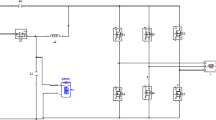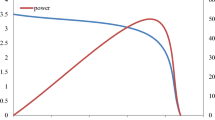Abstract
Fossil fuels will eventually be phased out because they are unsustainable, and their combustion releases harmful pollutants. Therefore, renewable energy sources (RES) are used instead of fossil fuels to generate electricity. The most important aspect of RES is its unlimited and infinite supply. In addition, the RES, including wind, solar, geothermal, tidal, hydroelectric, and others, offers clean, environmentally favorable energy sources. Photovoltaic (PV) systems are widely used in power systems due to their accessibility and low maintenance requirements. Solar energy is abundant and produces clean energy compared to other renewable energy sources. The ambient temperature and irradiance substantially impact the energy produced by solar PV (SPV). The atmosphere rapidly modifies the temperature and irradiance. This article employs maximum power point tracking (MPPT) strategies to boost energy production. The MPPT controller is used to produce maximum power from the RES. The incremental conductance is combined with the emperor penguin optimization algorithm to utilize the greatest SPV power. The buck converter reduces the voltage using the extracted peak power of the SPV. To provide a reduced harmonic voltage waveform in the output, multi-level inverters are used. Increasing the level counter of a staircase waveform improves the output voltage quality. A 51-level inverter is utilized for this, which consists of many MOSFET switches to produce a 51-level output waveform. The 51-level inverter’s current is controlled by the proportional resonance-based rain optimization algorithm (PR-ROA) controller, which also provides efficient switch tuning. In this situation, ROA adjusts the settings of PR and leads to reduced total harmonic distortion output signals.































Similar content being viewed by others
Data availability
Data sharing is not applicable to this article.
References
Macaulay J, Zhou Z (2018) A fuzzy logical-based variable step size P&O MPPT algorithm for photovoltaic system. Energies 11(6):1340
Hassan AS, Cipcigan L, Jenkins N (2017) Optimal battery storage operation for PV systems with tariff incentives. Appl Energy 203:422–441
Zahab EEA, Zaki AM, El-sotouhy MM (2017) Design and control of a stand-alone PV water pumping system. J Electr Syst Inf Technol 4(2):322–337
Mosa M, Shadmand MB, Balog RS, Abu Rub H (2017) Efficient maximum power point tracking using model predictive control for photovoltaic systems under dynamic weather condition. IET Renew Power Gener 11(11):1401–1409
Yang Y, Wen H (2019) Adaptive perturb and observe maximum power point tracking with current predictive and decoupled power control for grid-connected photovoltaic inverters. J Mod Power Syst Clean Energy 7(2):422–432
Singh SN (2017) Selection of non-isolated DC–DC converters for solar photovoltaic system. Renew Sustain Energy Rev 76:1230–1247
Gupta AK, Gupta M, Saxena R (2018) Modeling and comparative analysis of PV module with improved perturbation and observation based MPPT technique for PV applications. Arch Curr Res Int 15(1):1–2
Priyadarshi N, Padmanaban S, Maroti PK, Sharma A (2018) An extensive practical investigation of FPSO-based MPPT for grid integrated PV system under variable operating conditions with anti-islanding protection. IEEE Syst J 13(2):1861–1871
Premila T, Kumar R (2018) A comprehensive review on various optimization techniques assisted perturb and observe MPPT algorithm for a PV system. Int J Pure Appl Math 118(5):51–63
Priyadarshi N, Bhaskar MS, Padmanaban S, Blaabjerg F, Azam F (2020) New CUK–SEPIC converter based photovoltaic power system with hybrid GSA–PSO algorithm employing MPPT for water pumping applications. IET Power Electron 13(13):2824–2830
Priyadarshi N, Padmanaban S, Holm-Nielsen JB, Bhaskar MS, Azam F (2020) Internet of things augmented a novel PSO-employed modified zeta converter-based photovoltaic maximum power tracking system: hardware realization. IET Power Electron 13(13):2775–2781
Yussif N, Sabry OH, Abdel-Khalik AS, Ahmed S, Mohamed AM (2020) Enhanced quadratic V/f-based induction motor control of solar water pumping system. Energies 14(1):104
Padmanaban S, Priyadarshi N, Bhaskar MS, Holm-Nielsen JB, Hossain E, Azam F (2019) A hybrid photovoltaic-fuel cell for grid integration with jaya-based maximum power point tracking: experimental performance evaluation. IEEE Access 7:82978–82990
Padmanaban S, Priyadarshi N, Holm-Nielsen JB, Bhaskar MS, Azam F, Sharma AK, Hossain E (2019) A novel modified sine-cosine optimized MPPT algorithm for grid integrated PV system under real operating conditions. IEEE Access 7:10467–10477
Padmanaban S, Priyadarshi N, Bhaskar MS, Holm-Nielsen JB, Ramachandaramurthy VK, Hossain E (2019) A hybrid ANFIS-ABC based MPPT controller for PV system with anti-islanding grid protection: experimental realization. IEEE Access 7:103377–103389
Priyadarshi N, Padmanaban S, Mihet-Popa L, Blaabjerg F, Azam F (2018) Maximum power point tracking for brushless DC motor-driven photovoltaic pumping systems using a hybrid ANFIS-FLOWER pollination optimization algorithm. Energies 11(5):1067
Priyadarshi N, Sharma AK, Azam F (2017) A hybrid firefly-asymmetrical fuzzy logic controller based MPPT for PV-wind-fuel grid integration. Int. J. Renew. Energy Res. 7(4):1546–1560
Huang YP, Chen X, Ye CE (2018) A hybrid maximum power point tracking approach for photovoltaic systems under partial shading conditions using a modified genetic algorithm and the firefly algorithm. Int J Photoenergy 2018
Kumar J, Bahrani P (2017) Comprehensive review on maximum power point tracking methods for SPV system. Int Res J Eng Technol 4:1634–1639
Erdem Z (2017) A review of MPPT algorithms for partial shading conditions. Acta Phys Pol A 132(3):1128–1133
Alajmi BN, Marei MI, Abdelsalam I (2020) A multiport DC–DC converter based on two-quadrant inverter topology for PV systems. IEEE Trans Power Electron 36(1):522–532
Marei MI, Alajmi BN, Abdelsalam I, Alhajri MF (2018) A PV interface system based on high-gain high-frequency link converter. In: 2018 53rd International Universities Power Engineering Conference (UPEC), pp 1–6. IEEE
Jino Ramson SR, Lova Raju K, Vishnu S, Anagnostopoulos T (2019) Nature inspired optimization techniques for image processing: a short review. Nature Inspired Optim Tech Image Process Appl 113–45
Alsumiri M (2019) Residual incremental conductance based nonparametric MPPT control for solar photovoltaic energy conversion system. IEEE Access 7:87901–87906
Anowar MH, Roy P (2019) A modified incremental conductance based photovoltaic MPPT charge controller. In: 2019 International conference on electrical, computer and communication engineering (ECCE) (pp 1–5). IEEE
Shahid H, Kamran M, Mehmood Z, Saleem MY, Mudassar M, Haider K (2018) Implementation of the novel temperature controller and incremental conductance MPPT algorithm for indoor photovoltaic system. Sol Energy 163:235–242
Iskandar HR, Prasetya A, Zainal YB, Hidayat MR, Taryana E, Megiyanto G (2020) Comparison model of buck-boost and zeta converter circuit using MPPT control incremental conductance algorithm. In: 2020 International Conference on Sustainable Energy Engineering and Application (ICSEEA) (pp. 185–190). IEEE.
Saleh AL, Obed AA, Hassoun ZA, Yaqoob SJ (2020) Modeling and simulation of a low cost perturb & observe and incremental conductance MPPT techniques in proteus software based on flyback converter. In: IOP Conference Series: Materials Science and Engineering 881(1):012152. IOP Publishing
Singh Chawda G, Prakash Mahela O, Gupta N, Khosravy M, Senjyu T (2020) Incremental conductance based particle swarm optimization algorithm for global maximum power tracking of solar-pv under non-uniform operating conditions. Appl Sci 10(13):4575
Palanivel M, Kaithamalai U, Parthsarathi P (2020) Performance assessment of IC and ANFIS based MPPT for PV System using Super Lift Boost Converter. In: 2020 4th International conference on electronics, communication and aerospace technology (ICECA) (pp. 6–11). IEEE
Gupta A (2022) Power quality evaluation of photovoltaic grid interfaced cascaded H-bridge nine-level multi-level inverter systems using D-STATCOM and UPQC. Energy 238:121707
Baksi SK, Behera RK (2023) A reduced switch count seven-level boost ANPC based grid following inverter topology with photovoltaic integration. IEEE Trans Ind Appl
Malle L, Mittal A, Kumar S. A single phase grid-integrated PV system using cascaded PI and PR controller for power quality improvement
Bounabi M, Kaced K, Ait-Cheikh MS, Larbes C, Dahmane ZE, Ramzan N (2018) Modelling and performance analysis of different multi-level inverter topologies using PSO-MPPT technique for grid connected photovoltaic systems. J Renew Sustain Energy 10(4):043507
Premkumar M, Chandrasekaran K, Sowmya R (2020) Mathematical modelling of solar photovoltaic cell/panel/array based on the physical parameters from the manufacturer’s datasheet. Int J Renew Energy Dev 9(1):7
Çelik Ö, Teke A (2017) A Hybrid MPPT method for grid connected photovoltaic systems under rapidly changing atmospheric conditions. Electr Power Syst Res 152:194–210
Dhiman G, Kumar V (2018) Emperor penguin optimizer: a bio-inspired algorithm for engineering problems. Knowl-Based Syst 159:20–50
Dhiman G (2021) ESA: a hybrid bio-inspired metaheuristic optimization approach for engineering problems. Eng Comput 37:323–353
Moazzeni AR, Khamehchi E (2020) Rain optimization algorithm (ROA): a new metaheuristic method for drilling optimization solutions. J Petrol Sci Eng 195:107512
Thiyagarajan V (2020) Simulation analysis of 51-level inverter topology with reduced switch count. Mater Today: Proc 33:3870–3876
Niraimathi R, Seyezhai R (2020) Analysis, simulation and implementation of a novel dual bridge asymmetric cascaded multi level inverter using MGWO-PI-PWM controller. Microprocess Microsyst 77:103103
Srinivasarao B, Srinivasarao K and Sreenivasan G (2017) A new proposed topology of 51 level Multi level Inverter with Reduced number of components
Babaei E, Kangarlu MF, Hosseinzadeh MA (2013) Asymmetrical multi-level converter topology with reduced number of components. IET Power Electron 6(6):1188–1196
Priyadharsini S, Kannan C, Babu G, Savithri C, Thamayandhi K (2022) Design and development of 51 level non modular multi-level inverter topology with reduced number of switches and conduction path. EPRA Int J Res Dev 7(6):267–273
Funding
No funding is provided for the preparation of manuscript.
Author information
Authors and Affiliations
Contributions
All authors read and approved the final manuscript.
Corresponding author
Ethics declarations
Competing interests
The authors declare no competing interests.
Consent to participate
All the authors involved have agreed to participate in this submitted article.
Consent to publish
All the authors involved in this manuscript give full consent for publication of this submitted article.
Ethical approval
This article does not contain any studies with human participants or animals performed by any of the authors.
Additional information
Publisher's Note
Springer Nature remains neutral with regard to jurisdictional claims in published maps and institutional affiliations.
Rights and permissions
Springer Nature or its licensor (e.g. a society or other partner) holds exclusive rights to this article under a publishing agreement with the author(s) or other rightsholder(s); author self-archiving of the accepted manuscript version of this article is solely governed by the terms of such publishing agreement and applicable law.
About this article
Cite this article
Vijayvargiya, S.P., Sharma, V.K. & Nema, P. A novel topology for power quality improvement using EPO incremental conductance MPPT controller for SPV system with 51-level inverter. Electr Eng 105, 3363–3382 (2023). https://doi.org/10.1007/s00202-023-01878-4
Received:
Accepted:
Published:
Issue Date:
DOI: https://doi.org/10.1007/s00202-023-01878-4




